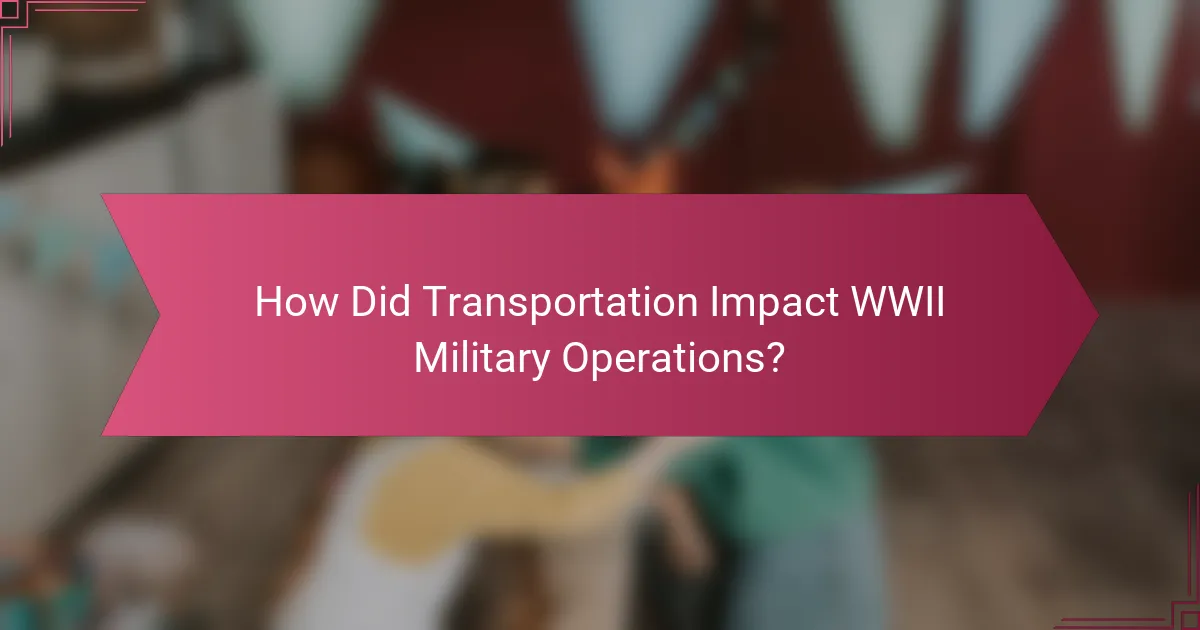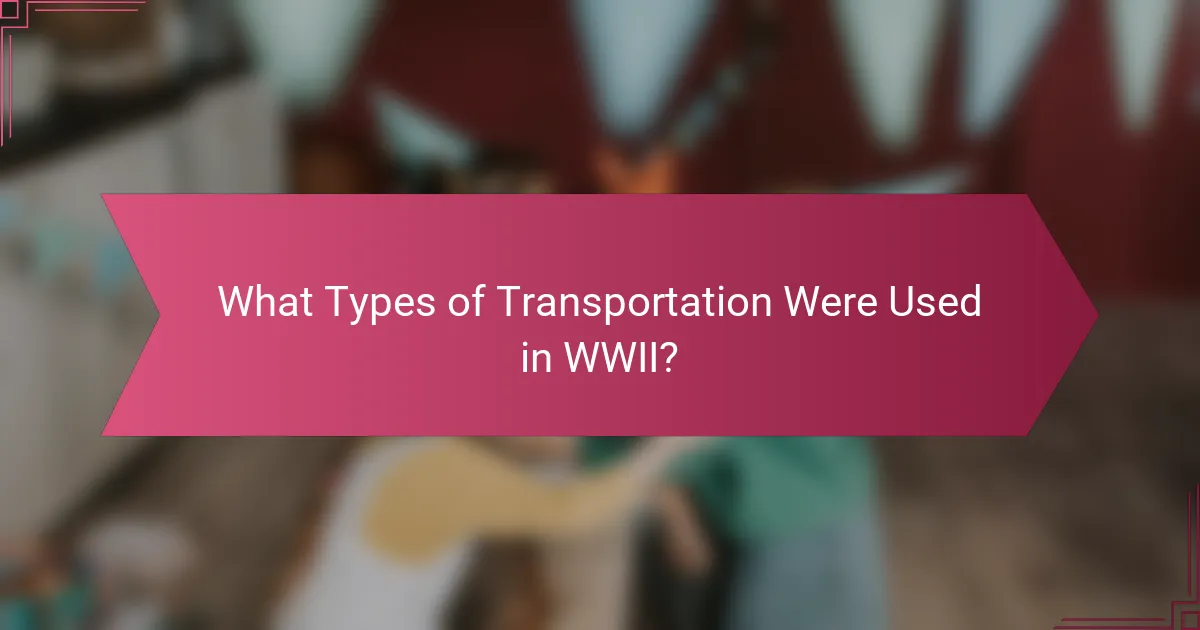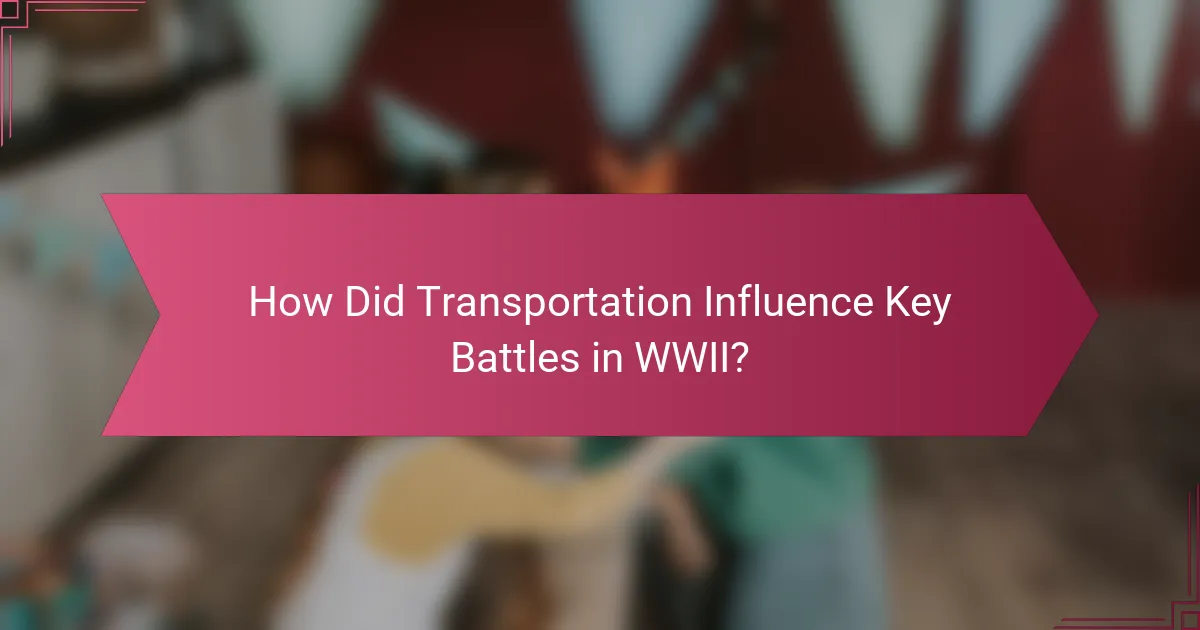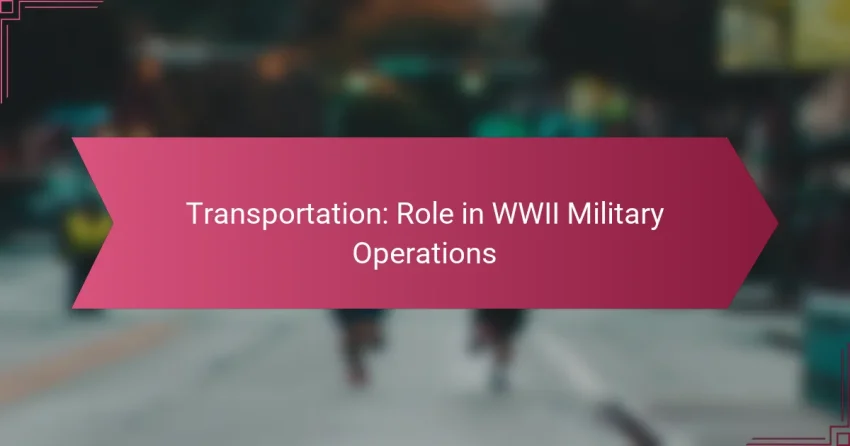Transportation was vital to military operations during World War II, facilitating the movement of troops, equipment, and supplies over extensive distances. The effectiveness of land vehicles, aircraft, and naval vessels was crucial for maintaining momentum in battles and ensuring that forces received the necessary support and resources across various theaters of war.

How Did Transportation Impact WWII Military Operations?
Transportation played a crucial role in World War II military operations by enabling the movement of troops, equipment, and supplies across vast distances. Effective transportation systems were essential for maintaining momentum in battles and ensuring that forces were adequately supplied and supported.
Logistical support for troop movements
Logistical support for troop movements involved the planning and execution of transporting soldiers to various fronts. Railroads, trucks, and ships were vital in moving large numbers of troops quickly and efficiently. For example, the use of rail networks allowed for the rapid deployment of divisions, often within days, to critical battle zones.
Challenges included managing the timing and coordination of transport vehicles to avoid delays. Military planners had to consider the availability of routes, potential enemy attacks, and the condition of vehicles to ensure troops arrived ready for combat.
Supply chain management for resources
Effective supply chain management was essential for ensuring that military forces had access to necessary resources like food, ammunition, and medical supplies. This involved establishing supply depots and using various transportation methods to deliver goods to frontline units. For instance, during the Normandy invasion, the Allies established a robust supply chain that included a combination of airlifts and naval transport.
Maintaining a steady flow of supplies required careful tracking and forecasting of needs, as well as contingency plans for disruptions. Poor supply chain management could lead to shortages that severely impacted operational effectiveness.
Strategic planning for invasions
Strategic planning for invasions relied heavily on transportation capabilities to ensure that forces could land and operate effectively in enemy territory. The planning process included selecting landing sites, determining the number of troops and equipment to transport, and coordinating the timing of landings with naval and air support.
For example, the D-Day invasion in 1944 involved meticulous planning of transportation logistics to land over 156,000 troops on the beaches of Normandy. This required not only ships and landing crafts but also the establishment of temporary ports to facilitate ongoing supply and reinforcement.

What Types of Transportation Were Used in WWII?
World War II relied heavily on various types of transportation, including land vehicles, aerial transport, and naval vessels, each playing a crucial role in military operations. These transportation methods facilitated troop movements, supply deliveries, and strategic deployments across multiple theaters of war.
Land vehicles: tanks and trucks
Land vehicles, particularly tanks and trucks, were essential for ground operations during WWII. Tanks provided armored support and firepower, enabling forces to breach enemy lines, while trucks transported troops and supplies across diverse terrains.
Commonly used trucks included the GMC CCKW, which could carry heavy loads and was vital for logistics. The mobility offered by these vehicles allowed for rapid advancements and retreats, making them indispensable in various campaigns.
Aerial transport: planes and gliders
Aerial transport, including planes and gliders, revolutionized military logistics in WWII. Aircraft were used for strategic bombing, reconnaissance, and troop transport, while gliders enabled the delivery of troops and equipment directly into combat zones without the need for airstrips.
Notable aircraft like the C-47 Skytrain could carry large numbers of paratroopers or cargo, significantly impacting operations such as the D-Day invasion. The use of gliders, such as the Waco CG-4A, allowed for surprise assaults, enhancing tactical advantages.
Naval vessels: ships and submarines
Naval vessels, including ships and submarines, played a pivotal role in WWII maritime operations. Aircraft carriers and battleships were crucial for naval dominance, while submarines conducted stealthy attacks on enemy supply lines.
For instance, the aircraft carrier USS Enterprise was instrumental in the Pacific Theater, projecting air power over vast distances. Submarines, like the German U-boats, targeted Allied shipping, demonstrating the importance of naval warfare in disrupting supply chains and maintaining control of sea routes.

How Did Transportation Influence Key Battles in WWII?
Transportation played a crucial role in World War II by enabling the movement of troops, equipment, and supplies, which significantly influenced the outcomes of key battles. Efficient logistics and supply chains were essential for maintaining military operations and ensuring that forces were adequately supported in various theaters of war.
D-Day: Operation Overlord logistics
On June 6, 1944, D-Day marked the beginning of Operation Overlord, the Allied invasion of Normandy. The success of this operation relied heavily on meticulous planning and execution of transportation logistics, including the movement of troops, vehicles, and supplies across the English Channel.
Prior to the invasion, extensive preparations were made, including the construction of artificial harbors, known as Mulberries, to facilitate the unloading of supplies. The Allies utilized a combination of naval and aerial transport to ensure that forces could land and establish a foothold in France quickly.
Battle of the Bulge supply lines
The Battle of the Bulge in late 1944 was a surprise German offensive that aimed to split Allied forces and capture vital supply routes. The effectiveness of the German attack was initially bolstered by their ability to move troops and equipment rapidly through the Ardennes forest.
However, the Allies’ resilience was largely due to their robust supply lines and the ability to reinforce positions despite harsh winter conditions. Maintaining open supply routes allowed the Allies to sustain their counteroffensive, ultimately leading to the defeat of German forces.
Pacific Theater: island hopping strategy
In the Pacific Theater, the island hopping strategy was pivotal for the Allies in their campaign against Japan. This approach involved capturing strategically important islands and using them as bases for further operations, which required effective transportation of troops and supplies across vast ocean distances.
Logistics in this theater included the use of aircraft carriers, amphibious landing craft, and supply ships to support operations. The ability to establish airfields on captured islands allowed for increased mobility and facilitated the continuous advancement toward Japan, demonstrating the critical role of transportation in military strategy.

What Were the Innovations in Transportation During WWII?
World War II saw significant innovations in transportation that greatly enhanced military operations. Key advancements included the development of amphibious vehicles, improvements in aircraft design, and more efficient naval logistics systems.
Development of amphibious vehicles
The development of amphibious vehicles during WWII allowed military forces to conduct operations across both land and water. These vehicles, such as the DUKW (often called “Duck”), facilitated the rapid deployment of troops and supplies during beach landings, notably in the Normandy invasion.
Amphibious vehicles were designed to navigate various terrains, making them versatile assets in combat. Their ability to transition from water to land without needing to unload made them essential for surprise assaults and quick retreats.
Advancements in aircraft design
Aircraft design underwent rapid advancements during WWII, focusing on speed, payload capacity, and range. Innovations included the introduction of long-range bombers like the B-29 Superfortress, which could carry significant bomb loads over vast distances.
Streamlined designs and powerful engines improved maneuverability and reduced flight times. The incorporation of radar and other technologies enhanced targeting accuracy, making air operations more effective in supporting ground troops and disrupting enemy supply lines.
Improved naval logistics systems
Naval logistics systems were significantly improved during WWII to support large-scale maritime operations. The establishment of efficient supply chains ensured that fleets received necessary provisions, ammunition, and fuel in a timely manner.
Techniques such as convoy systems and the use of specialized supply ships helped protect cargo from enemy attacks while maintaining the flow of resources. These logistics innovations were crucial for sustaining prolonged military engagements across the vast oceans.

How Did Transportation Shape Post-War Military Strategies?
Transportation played a crucial role in shaping post-war military strategies by enhancing logistical capabilities and enabling rapid deployment of forces. The lessons learned from World War II led to significant advancements in military logistics, influencing how nations prepared for future conflicts.
Transition to Cold War logistics
The transition to Cold War logistics emphasized the need for efficient supply chains and rapid troop movements. Military planners recognized that the ability to mobilize forces quickly could be decisive in a potential conflict with the Soviet Union. This led to the establishment of extensive transportation networks, including airlift capabilities and improved road and rail systems.
For example, the U.S. developed the Military Airlift Command to ensure rapid deployment of troops and equipment. This capability allowed for strategic positioning of forces across Europe and Asia, significantly enhancing deterrence strategies during the Cold War.
Influence on NATO transportation policies
NATO’s transportation policies were heavily influenced by the logistical challenges faced during World War II. The alliance prioritized interoperability among member nations to ensure seamless movement of troops and supplies. Standardization of equipment and procedures became essential to facilitate joint operations.
Additionally, NATO established the Allied Command Europe Rapid Reaction Corps, which focused on improving transportation infrastructure and logistics planning. This initiative aimed to enhance readiness and response times in the event of a conflict, reflecting the lessons learned from past military operations.
Legacy of WWII transport innovations
The innovations in transportation during World War II left a lasting legacy on military operations. Technologies such as containerization and advanced airlift capabilities revolutionized how armies moved supplies and personnel. These advancements set the stage for modern military logistics, emphasizing efficiency and speed.
Furthermore, the integration of technology in transportation planning, such as computer modeling and real-time tracking systems, has roots in the logistical strategies developed during WWII. These innovations continue to shape military operations today, ensuring that forces can be deployed quickly and effectively in response to emerging threats.
